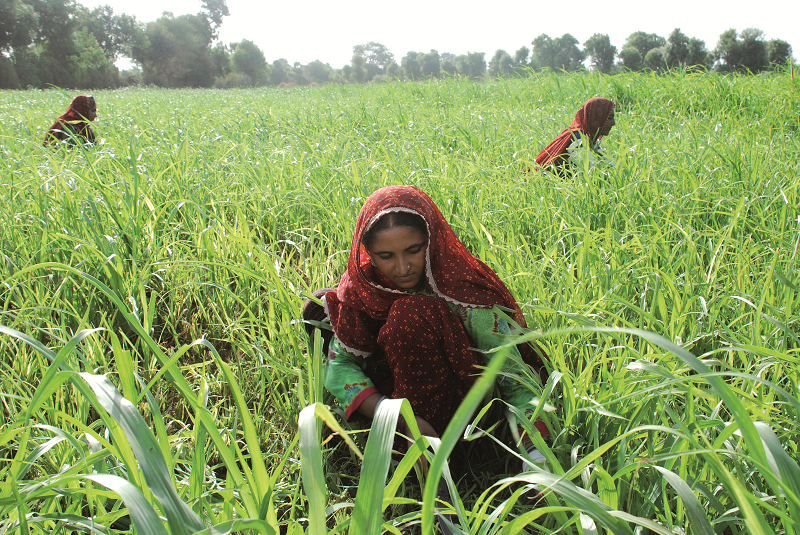
Fodder Development Programme
A. Green Fodder Production Enhancement
Green fodder is an economic source of nutrients for the livestock. However its availability in the country is limited. With the limited land under fodder cultivation, there is a need to focus to improve productivity of fodder crops & common grazing lands and demonstrate to conserve surplus green fodder to enhance availability during the lean period.
1. Improved Fodder Seed Production Programme
Seed is the most critical input to enhance the productivity of fodder crops. To ensure supply of quality seeds to the farmers, production of seeds will be enhanced by establishing seven new seed processing units. The seed units involves production, processing & marketing of quality fodder seeds and comprises seed cleaning and grading machines, civil buildings and human resource. It aims at producing additional 8000 MT certified/truthfully labelled fodder seeds, annually by the end of 6th year of the project through registered seed growers, following standard seed production protocol.
2. Silage Making Demonstration
To ensure year round availability of quality fodder silage making, a practice to conserve surplus quantity of green fodder, is to be popularised. Through silage making large quantity of green fodder can be preserved for longer period without significant loss of quality and palatability. Silage contains around 65-70 percent moisture and preserved due to fermentation of sugars available in the green fodder through anaerobic fermentation. Silage can be fed to livestock in place of green fodder.
3. Demonstration of Re-vegetation of Common Grazing Land
The grazing lands play an important role in the lives of rural people who are getting fodder, fuel, drinking water from commons. However, such lands are being continuously degraded due to overgrazing and overexploitation by locals. Re-vegetation of such lands on scientific lines suiting to agro-climatic conditions is to be demonstrated through strengthening institutional arrangement at village level. Fodder production from such lands can be enhanced substantially by introducing high yielding cultivated fodder crops, grasses and pasture legumes. An integrated approach of growing cultivated crops, grasses, trees and shrubs under silvi-pastural/ horti - silvipasture system will improve overall productivity of such land.
B. Crop Residue Management
1. Demonstration of Mowers
Due to rising cost of agricultural workers use of grain harvesters is increasing leading to wastage of straw in the field of farmers, especially when tractor or engine driven straw mowers and pick up devices are not available. Various types of mowers are to be demonstrated under NDP I.
a. Simple mowers: These mowers harvest the fodder crops at ground level and leave the biomass in the field for sun drying or direct grazing or manual collection or by mechanical means.
b. Mowers with auto pick up: Such mowers are designed to perform many operations in single pass of tractor. Activities like fodder harvesting, chopping, loading of trailer, baling etc are carried out automatically by tractor power in single action without any labour. Depending on usage and attachments, the auto pick up mowers are further classified into following categories:
b.1 Mower with auto threshing and loading (wheat straw or Rabi harvest special)
b.2 Mower with auto chopping and loading (multi crop universal design)
b.3 Mower with auto binder or auto liner for cereal crops, green fodder & stubble attachments. Such mowers are termed as combine prevention mowers
b.4 Swather or crop liner attachments for collection, aeration & sun drying
b.5 Automatic pick up baler with or without cutter head depending on tractor capacity
Universal design multi crop mowers have better pay back due to usefulness in silage, hay & green fodder as well. Field mowers in the capacity range 5 to 75 HP, for 5 to 25 acres per day are available.
2. Demonstration of Biomass Stores
Infrastructure for straw management and storage has been grossly neglected in India. Universal design stores and bunkers for straw, pellets, bales, blocks and silage having better pay back would be demonstrated under NDP I.
3. Crop Residue Enrichment & Densification
Crop residues form bulk of basal diet of ruminants in India. Crop residues are not uniformly available across the country, some areas are surplus while some are deficit on regular basis. For such locations crop residues can be fortified with feed ingredients like cakes, brans, grains, molasses, hay, minerals and then densified into blocks or pellets to save on storage and transport costs. Also balanced ration in the form of complete diet or total mixed ration as per need of animals can be supplied for improved productivity.